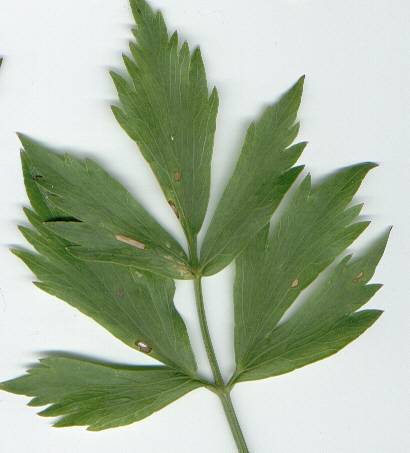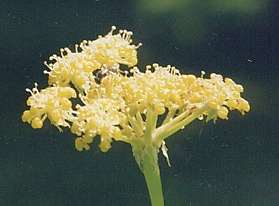| ||
|
| ||
|
Today, lovage is still common in Southern and Central Europe, but it has not found many friends outside this region. Its characteristic flavour fits well to sour pickles and aromatic vinegars (see dill); furthermore, beef stock is commonly flavoured with lovage leaves (see parsley on German versions of bouquet garni). In Germany, lovage is a popular flavouring for potato dishes.
In Italy, lovage usage culminates in Liguria, where of old the spice is cultivated (see above). Lovage is chiefly needed for tomato sauces, often in combination with oregano; it may be efficiently combined with rue.
The contemporary distribution of lovage, encompassing the Alps and Southern Germany, can be traced back to the early Middle Ages: At the begin of the 9.th century, Charlemagne wrote an edict called Capitulare de villis vel curtis imperii Caroli Magni in which he defined a large number of administrative, legal and particularly agricultural rules for the Frankish empire. At the end of the document, we find a large list of culinary and medical herbs that should be grown in every Imperial garden.
All the capitularia were written in a sort of Medieval Latin, which was the only language spoken and understood all over the empire. Move the mouse over the Latin text to see the translation of the plant names (HTML 4.0, CSS level 1).
Volumus quod
in horto
omnes herbas habeant,
id est
lilium,
rosas,
fenigrecum,
costum,
salviam,
rutam,
abrotanum,
cucumeres,
pepones,
cucurbitas,
fasiolum,
ciminum,
ros marinum,
careium,
cicerum italicum,
squillam,
gladiolum,
dragantea,
anesum,
coloquentidas,
solsequiam,
ameum,
silum,
lactucas,
git,
eruca alba,
nasturtium,
parduna,
puledium,
olisatum,
petresilinum,
apium,
levisticum,
savinam,
anetum,
fenicolum,
intubas,
diptamnum,
sinape,
satureiam,
sisimbrium,
mentam,
mentastrum,
tanazitam,
neptam,
febrefugiam,
papaver,
betas,
vulgigina,
mismalvas,
id est
althaea,
malvas,
carvitas,
pastenacas,
adripias,
blidas,
ravacaulos,
caulos,
uniones,
britlas,
porros,
radices,
ascalonicas,
cepas,
alia,
warentiam,
cardones,
fabas maiores,
pisos mauriscos,
coriandrum,
cerfolium,
lacteridas,
sclareiam.
Et ille hortulanus
habeat
super domum suam
Iovis barbam.
De arboribus
volumus
quod habeant
pomarios,
diversi generis,
prunarios,
diversi generis,
sorbarios,
mespilarios,
castanearios,
persicarios,
diversi generis,
cotoniarios,
avellanarios,
amandalarios,
morarios,
lauros,
pinos,
ficus,
nucarios,
ceresarios
diversi generis.
The paragraph closes with some more lines concerning different breeds
of apple trees. Some plants from the above list cannot be unambiguously
identified botanically; see also pomegranate
about the difficulties in identifying plants mentioned in the bible.
Due to its enumerative nature, it is difficult to render the text in
an easy-to-read way, especially if alternative plant identifications
shall also be indicated. The following is a compromise aimed for
improving readability; move the mouse over the text to see
modern botanical names (HTML 4.0, CSS level 1).

|
| Lovage flower clusters |
We want that they should have all herbs in the garden, this isflag (?), dog rose, fenugreek, costmary, sage, rue, southernwood, cucumbers, musk melons, bottle gourds,cowpea (?), cumin, rosemary, caraway, chickpea, squill, gladiolus,snakeweed (?, ?) , anise,cococynth (?), heliotrope (?), baldmoney (?) sermountain,lettuce (?), nigella, rocket, watercress, burdock, pennyroyal,angelica (?), parsley, celery, lovage, savine, dill, fennel, chicory, burningbush, mustard, savory, water mint, spearmint, horse mint, tansy, catmint,centaury (?), poppy, Swiss chard, hazelwort, all mallows, that is marsh mallow and common mallow, carrots, parsnips, orache, amaranth, turnip, cabbage,onions (?), chives, leeks, radish, shallots, onions, garlic, madder,fuller's teasel (?), broad bean, peas, coriander, chervil, caper spurge, clary sage. And each gardener shall have roof houseleek (Jupiter's beard) growing on the top of his house.Of the trees, we wish that they should have
apples (?) of various kinds, plums of various kinds, sorbs, medlars, chestnuts, peaches of various kinds, quinces, hazelnuts, almonds, mulberries, bay laurel, stone pines, fig, walnuts,sweet cherries (?) of various kinds.

|
| Young lovage plants |
The Capitulare de villis helped greatly in the
unification of agricultural technologies, and it provided for
a superregional distribution of cultigens and the know-how associated
with them. The plant list of Charlemagne kept its canonical character
during the whole Middle Ages, up to the 18.th century: The
plants of Charlemagne
were grown in monasteries
of suitable climate.
Many culinary herbs of Mediterranean origin became known, by means of the Capitulare, in the more Northern parts of Central and West Europe; some of them could establish themselves permanently in those cooler regions, where their growing may need more care, or more breeding effort. Examples include lovage, parsley and celery; also southernwood could be named, as it has survived in German or British peasants’ gardens to this day. Other Carolingian cultigens, however, were abandoned for climatic reasons (e. g., almond) or got suppressed by others (e. g., cumin).
Although the fruits of lovage can be used as a spice, they are (to my
knowledge) not traded. Sometimes, however, ajwain
fruits are mislabeled as lovage seed
. True lovage seeds are required
in some of the ancient Roman Apicius recipes (see
silphion).











